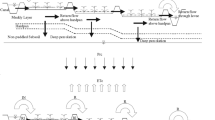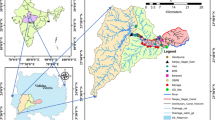Abstract
This research is to construct a water balance model to estimate the amount of return flow in an irrigation system. A simple computation framework for the model was established to include various irrigation applications in cropping seasons. The model was able to estimate evapotranspiration, deep percolation into groundwater aquifer, and return flow. Return flow can be split into two parts, which are surface and subsurface return flows. The water balance model was then applied at the irrigation system (rotational block No. 11-2 of five paddy field units) which is operated by the Taoyuan Irrigation Association in Taiwan as an example. Two study cases were simulated, in which one was for using return flow and the other one was for using no return flow. The study period for the model simulations is the first rice cropping term in 2010 which was from February 16 to July 10. As a result, return flows calculated by the model were 27, 27, 34, and 39% of outflows for sandy loam, sandy clay, clay loam, and light clay soil, respectively. Irrigation water at the downstream field unit with use of return flow was supplemented by the upstream field units, and the amount is 5–8% of irrigation water for using no return flow. Furthermore, it can be seen from the simulations that increases in irrigation water provide increases of return flow. Increases of irrigation water result in slight increases of subsurface return flow, while increases of irrigation water cause nearly none of change in deep percolation.










Similar content being viewed by others
References
Allen RG, Pereira LS, Raes D, Smith M (1998) Crop evapotranspiration, FAO Irrigation and Drainage Paper 56. Food and Agriculture Organization of the United Nations, Rome
Aron G (1992) Adoption of Horton and SCS infiltration equation to complex storms. J Irrig Drain Eng, ASCE 118(2):275–284
Bauer SW (1974) A modified Horton equation during intermittent rainfall. Hydrol Sci Bull 19(2/6):219–229
Bouman BAM, Wopereis MCS, Kropff MJ, ten Berge HFM, Tuong TP (1994) Water use efficiency of flooded rice fields. (II) Percolation and seepage losses. Agric Water Manage 26:291–304
Chien CP (2003) Experiments and Simulation for Infiltration and Return Flow in Paddy Fields, PhD Thesis, Department of Civil Engineering, National Central University, Taiwan (in Chinese)
Chien CP, Wu RS (2003) Experimental and modeling studies on return flow in the runoff reuse system. J Chin Agric Eng 49(3):30–45 (in Chinese)
Chien CP, Lee TC, Lee YJ, Wu RS, Wen JC, Neou JC (2000) Measurement and primitive study on the return flow for paddy field. In: Proceeding of the conference of chinese society of agriculture engineering, 2000, pp 393–399 (in Chinese)
Chow VT, Maidment DR, Mays LW (1988) Applied hydrology. McGraw-Hill, New York
Graf WH (1998) Fluvial hydraulics. Wiley, Chichester
Gronning Engineering Company (1989) Ground water development, augmentation and exchange plans for the city of Colorado Springs. Rep, Denver
Huang HC, Liu CW, Chen SK, Chen JS (2003) Analysis of percolation and seepage through paddy bunds. J Hydrol 284:13–25
Kovacs G (1981) Seepage hydraulics. Elsevier, New York
Oad R, DiSpigno M (1997) Water rights to return flow from urban landscape irrigation. J Irrig Drain Eng, ASCE 123(4):293–299
Oad R, Lusk K, Podmore T (1997) Consumptive use and return flows in urban lawn water use. J Irrig Drain Eng, ASCE 123(1):62–69
Todd DV (1980) Groundwater hydrology. Wiley, New York
Tuong TP, Wopereis MCS, Marquez JA, Kropff MJ (1994) Mechanisms and control of percolation losses in irrigated puddle rice fields. Soil Sci Soc Am J 58:1794–1803
Walker SH, Rushton KR (1984) Verification of lateral percolation losses from irrigated rice fields by a numerical model. J Hydrol 71:335–351
Wetstein JH, Hasfurther VR, Kerr GL (1989) Return flow analysis of a flood irrigated alluvial aquifer: final report to Wyoming Water Research Center and Wyoming Water Development Commission
W.W. Wheeler and Associates (1987) Lysimeter study. Rep, Englewood
Wu RS, Haith DA (1993) Land use, climate and water supply. J Water Resour Plan Manage, ASCE 119(6):685–704
Wu RS, Sue WR, Chien CB, Chen CH, Chang JS, Lin KM (2001) A simulation model for investigating the effects of rice paddy fields on the runoff system. Math Comput Model 33:649–658
Author information
Authors and Affiliations
Corresponding author
Rights and permissions
About this article
Cite this article
Chien, CP., Fang, WT. Modeling irrigation return flow for the return flow reuse system in paddy fields. Paddy Water Environ 10, 187–196 (2012). https://doi.org/10.1007/s10333-011-0307-x
Received:
Revised:
Accepted:
Published:
Issue Date:
DOI: https://doi.org/10.1007/s10333-011-0307-x




